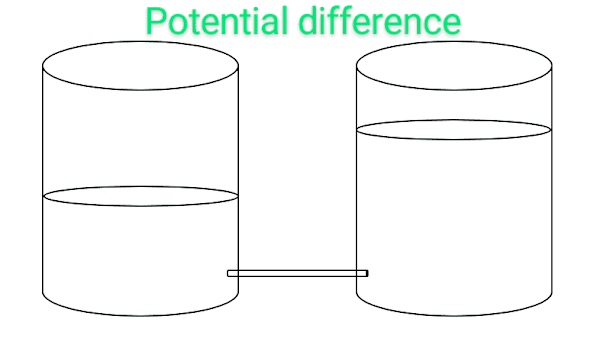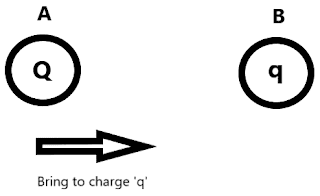Explain potential difference, work done and charge moved - State relation
State relation between Potential difference, work done and charge moved
Potential difference, work done and charge moved. You have heard these words in class 9. If you have remembered that there were a formula related there words. We can also say that formula as the relation between potential difference, work done and charge moved.In this post we will discuss about this relationship in more details. But before we proceed we have to clear our doubt about these terms. Potential difference, work done and charge moved.
So firstly we will define potential difference then work done and charge moved. After the definition of all these terms, we will state the relation between them. And to prove our relation we will also establish the derivation of that relation. So let's t with potential difference.
What is potential difference?
Potential difference is defined as the amount of work done to bring a unit charge from one position to another position.
In other words, potential difference is the difference of charges between two points because of the movement of change from first point to second point.
Let's suppose there are two point charge q¹ and q². Separated by the distance 'r'. Both the charges applying forces to each other weather it is repulsive or attractive.
Case 1:- (q¹>q²)
Let's suppose the force act on both the charges be repulsive. Due to this one chance q¹ applyed more force to q². So that q² moved away from q¹. Now the distance between both charges will be (r+1).
The potential difference between both the charges will be
Potential difference = work done / charge.
Case 2:- (q¹<q²)
In this case q² is greater than q¹. So that q² acquire more forces to the compare of q¹. Let's suppose q¹ and q² both are positive charges. S
Hence, here is also a repulsive force acts on each other. So due to the repulsive force q¹ get far away from q². Therefore the distance between both the charges will be r+1.
Here the formula of potential difference will be same as above
Potential difference = work done / charge.
S.I unit of Potential Difference is Volt.
To know more about potential difference. click here because here you can also know there is a direct connection of potential difference with ohm's law.
What is work done?
Work done is defined as the when we apply a force on something and body get displaced from its initial position then work is said to be done.
In other words work is said to be done when we apply a force 'F' on some body or object and body get displaced from its initial positions. If force is apply but body didn't get displaced from its initial position then work is not said to be done.
These are the some conditions that we have must follow for work done.
- force not should be zero.
- Body must cover some distance after force applied.
- Displacement should not be zero.
The formula for calculating work done is given by,
Work Done = force . Displacement
State the relation between potential difference, work done and charge moved
The main relation between potential difference, work done and charge moved is potential difference is always equal to the amount of work done per unit charge. Hence, the mathematical relation between potential difference, work done and charge moved will be,
Potential difference = work done / charge moved
lets understand this relation with the help of an example. suppose we have two charged bodies q and Q placed at the position A and B respectively. Both the body have 1 coulomb of charge in it. Now, If we bring the charge 'Q' to the charge 'q' then we have to do some work. So, in that case how much the amount of work will be done with respect of bringing charged is said to be potential difference.
Because of the movement of charge from one position to another position there must be the unbalanced quantity of charge. means when we brought the charge 'Q' to the charge 'q'. then the position B which had charge 'Q' will have loss of charge. but at position A. there will be gain of charge.
So Due to the loss or gain of charge between two points. There should be the difference in charge known as potential difference.
In the above fig. as you can see there are two points A and B having charges Q and q respectively. charge Q bring to charge q situated at the point B. At the time of bringing we apply some force to the charge Q. So that it moves toward the point B.
As we discussed above that when force applied and something start moving then work is done. hence, work will also done in the above case because we apply the force on charge Q and after force applied it started moving.
So, here work done with respect to the amount of charge we want to move. But as we discussed above that there are only 1 coulomb of charge on both the points A and B. So, the total work done will be the respect of 1 coulomb of charge. Suppose in the above case the total work done is W.
Therefore, potential difference will be equal to the W / 1 coulomb charge.
Potential Difference = W / C
Drive the relation between potential difference, work done and charge moved
As we above established the relation between potential difference, work done and charge moved is given by,
Potential Difference = work done / charge moved ----------------------- (1)
Now, lets drive the above equation.
If we define 1 Volt of potential difference then we can easily get the formula of the relation between potential difference, work done and charge moved.
1 Volt of potential difference is defined as the when 1 joule of work is done to bring a 1 coulomb of charge from one point to another point where the another charge situated then 1 Volt of potential difference generated between these two charges.
1 Volt = 1 Joule / 1 coulomb
Potential Difference = Work done / moved charge
We can also drive it with another method but this could be the simplest method. that is easy to understand.


